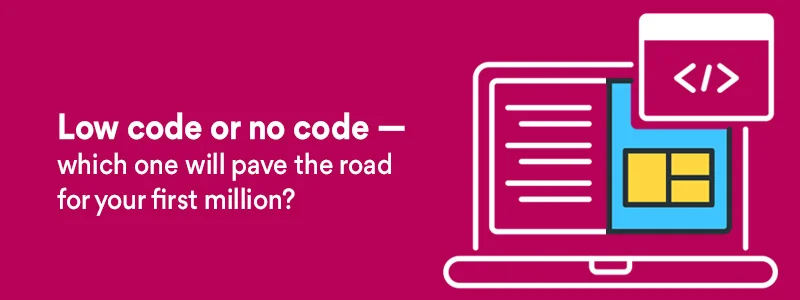
Low code, no code or traditional code—which one will pave the road for your first million?
Low-code, no-code (LCNC) is the orange to your black if you are looking to build an app or business. In a fast-paced world where horses are replaced by cars and humans by AIs, it is conspicuous that the need for software and IT engineers is gradually decreasing as the need for LCNC platforms is exponentially increasing. When the cost of using low-code or no-code applications is half as much as that of a programmer and comes with the flexibility of changing and adding new features without constant complaints of work overload, it would only make sense to opt for LCNC platforms. But to understand which would fit you better, let me break down the key differences between them both.
Traditional coding:
Let us first address the elephant in the room: Does this mean that programming from scratch has become obsolete? If you are a tech-geek developer with a lot of time on your hands and require a complex and exclusive application to be built, then traditional coding is the way to go. Traditional coding would mean that you would have to sow and harvest your own coffee beans. Building your source code from scratch demands absolute precision and meticulous detailing, but on the bright side, this will give you a tailor-made application where the deployment of updates can be made whenever you see fit. The application complexity can be calibrated to your preferences, which also increases the scalability of the application. The downside of it is having to read through lines and lines of code to debug errors, thereby consuming time and increasing testing costs. This would also require you to outsource expensive modules and integrations that aren’t available for free.
Now let us dive into the differences between low-code and no-code software,
Low-code software:
Before I cut into the juxtaposition of these software’s, if you fall under any of the following categories: professional developer, part of a moderately medium- to large-sized company, an IT developer, a cross-functional team, or a legacy company, then the best pick for you would be low-code software, as they can be more intricately designed. Low-code software gives you the opportunity to grind your own coffee beans instead of using an instant coffee mix. As I have already mentioned, the first difference is that low-code software has more range and malleability due to its permissibility of warping the source code into a customized rendition of your own ideas. The next one is that it would require a lot more complexity and come with a pool of integrations to choose from, like adding external code modules or third-party libraries. They prove to be more time-consuming, which inevitably tags along with the complexity.
No-code software:
As the name suggests, this literally means having to use zero code, or in this case, instant coffee, to get you going. Perfect for people with great innovation and not so great understanding of the vast sea that is coding. Startups, educational institutions, entrepreneurs, or anyone looking for a quick and hassle-free way to build apps or organize workflows should opt for this. It is far less time-consuming and comes with fewer code integrations. The compact and succinct nature of no-code software acts like Google Translator, where the language is a thousand lines of code. The drag and drop concept of no-code software makes it easily operable and reduces the need for debugging. The main theme of no-code software is that it is simple and is used for superfast app development. This helps speed up the process of starting businesses or helps to end tasks before narrow deadlines. Everything has its pros and cons so the important aspect is to find in which fraction your needs belong to and choose the best fit accordingly. These are the key differences between no-code, low-code and traditional coding. It boils down to your preference of homemade coffee beans or planting your own beans or instant coffee mix.



